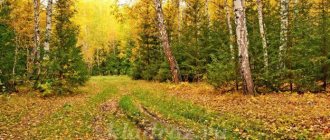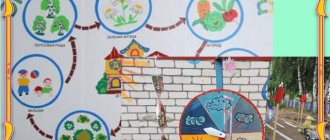MAGAZINE Preschooler.RF
PLAN - LESSON SUMMARY - excursions with middle group children on the topic: “A walk in the autumn park” Program content: 1. teach to study seasonal changes in nature (autumn foliage, bird migration); characteristic phenomena of autumn weather; teach environmentally correct behavior in nature; 2. promote the development of memory and logical thinking; 3. to cultivate in children the ability to admire autumn nature, a caring attitude towards it, and the ability to work.Vocabulary work: yellow - orange, drop, migratory, gratitude, rustle Preliminary work:
Conversation about autumn in the forest and park, conversations about migratory birds, observations of different trees at different times of the year, conversations about changes in tree leaves, preparing an excursion route, reading and learning the poem “Oak” by I. Tokmakova, “message” from the forest ( letter, basket with acorns) Literature: 1. E.G. Korotkova Teaching storytelling in kindergarten, M.; Education, 1978 2. M.M. Alekseeva, V.I. Yashina Speech development of preschool children, M.; Academy, 1999
Progress of the lesson: On the street (on the territory of the kindergarten), children’s attention is drawn to the sounds of autumn and the cries of birds. They determine that crows are calling. - Guys, look, one Crow flew closer to us, who is it? (Karkusha is sitting on a bush) Karkusha: - What are you listening to, guys? (sounds of autumn) - Why can’t you hear the singing of other birds? (all the birds flew to warmer regions, to the south) - Why? (cold weather is coming, autumn) - Where can you see autumn? (in the park, in the forest - in the trees) - Can you show? (yes, come with us into the forest, we will show and tell you everything)
Conversation on the way to Karkusha Park: - Why are there fewer people on the street? And whoever is dating is dressed warmly? (it has become cold, people try to stay indoors more, and if there is a need to go outside, they must dress warmly (jackets, hats, warm pants))
At the Karkusha pond: - Who swims in the pond? (ducklings that have grown up and are now preparing to fly south, but people can no longer swim - it’s very cold) In the park (They approach the maple tree) Karkusha: - What kind of tree is this? So beautiful? (This is a maple, its leaves have turned yellow-orange) - Why are the leaves so beautiful? (the leaves do not receive moisture from the ground, the trees are preparing for winter, shedding their leaves to make it easier to endure the cold) - And how many of them are there on earth! What can you do with them? (you can pick a beautiful bouquet, or you can just rustle) (Near the oak tree) - And this tree is very large and tall, it has a lot of green leaves, why? (this is an oak tree, one child recites a poem) I. Tokmakova “Oak” The oak tree is not afraid of rain and wind. Who said that an oak tree is afraid of catching a cold? After all, it remains green until late autumn. This means the oak is hardy, this means it is hardened. — It’s a beautiful tree and in general, the park is very beautiful, there are a lot of trees in multi-colored outfits, but something hits my paws, some pieces of paper, bottles, some kind of garbage? Can we help the park and clean it of “dirt”? (yes) - Here are hand gloves and garbage bags. Let's clear the paths of papers, bottles and bags.
Labor activity Children collect large garbage along the paths.
Rewarding The forest rustled and a leaf fell onto the path. Karkusha: - Another leaf fell, and on it something was written: “Walk along this path 10 steps forward and you will find my gift - gratitude for your help. Thanks for the help. Park" The children and Karkusha walk along the path and find a basket of acorns near a bush. - And what is it? (acorns, seeds from an oak tree, from which equally large trees can grow) - what can we do with them? (you can make crafts, or we can plant them in kindergarten so that oak trees will grow)
Bottom line: Thank you, forest, for the gift. We will definitely plant acorns so that big oak trees will grow. We’ll take the trash out to the trash can, and we’ll never leave papers or bags here. Goodbye.
| Next > |
Summary of the excursion “Nature in autumn”
EXCURSION
"Nature in autumn"
Methodological development of teacher Lopatina E.Yu.
GKOU RO boarding school of the VIII type in the village of Orlovsky
September 2015
Target:
fostering a friendly attitude towards nature during the period of its autumn withering, the ability to see and understand its beauty
Tasks
-With the help of observations, enrich children’s understanding of typical autumn phenomena. -Develop children's speech by selecting signs of objects and phenomena, activate vocabulary -Increase children's motor activity. -Promote the cohesion of relationships in the children's team
Progress of the excursion.
Educator. Today we are in a large clearing, which is located near our school. Let's first try to remember the rules of behavior in nature, name a few!
(Children’s answers: “don’t litter”, “don’t make noise”, don’t go far from adults”, “be attentive”, etc.)
Educator. Today we gathered in this clearing to admire the autumn colors of nature, play, relax and just chat together.
Look around. Tell me what nature looks like in autumn? Remember what words we used to describe the Russian forest in previous lessons?
Children's answers (Golden, crimson, elegant, beautiful, motionless,).
What can you hear in nature in autumn?
Children's answers (Blowing wind. Silence. The rustle of drying grass underfoot.)
Do you remember what sounds you hear in the summer? (Birds singing, rustling leaves). Why do you think it’s so quiet now? Why are there few birds? (With the arrival of autumn, there was little food, seeds, and berries, so some of the birds flew away, and those that remained moved closer to human habitation. It is easier to find food here and it is warmer).
Didactic game: “Name the migratory birds” (Children’s answers: “rooks, swallows, gray heron, lapwing, quail”)
Low mobility game “Flies - does not fly” (The teacher lists the names of animals and birds. Children wave their “wings” if a bird is named, and do not raise their hands if the leader named another animal. “Dove, bear, tit, tiger, hare, woodpecker , elk, sparrow, fox, hamster, falcon, eagle.")
Educator. We ran around and warmed up. Guess the riddle:
I bring the harvests, I sow the fields again, I send the birds to the south, I strip the trees, But I do not touch the pines and fir trees. I….autumn.
Competition game “Who can name the most words to describe autumn?
Children's answers: “Bright, golden, rainy, gloomy, different, wonderful)
Educator. Children, there are many sayings about autumn. Please tell me how you understand this saying: “Spring is red but hungry, autumn is rainy but nourishing.” (Children's answers)
Educator. Children, name the first month of autumn. (September). People call September “gloomy” because the sky is gloomy. Because of the winds he was nicknamed “howler”. They also call it “golden flower”, “deciduous plant”, since the first sign of the arrival of autumn is yellowing foliage and grass. Is September coming to replace it? (October). People call this month “leafy” (because of the falling leaves) and “mud” (because of the rains). October is one of the most picturesque months of the year, the month of “golden autumn”. And the last month of autumn, what is it called? (November) November is called “semi-winter” (winter has not yet entered into force, but is making itself felt). In ancient times, this month was referred to as the “ice smith”, since in November the temperature begins to stably stay below 0 degrees, snow falls and reservoirs freeze.
Educator. This is where our excursion ends. Today we talked about autumn. We will talk about her a lot more, you will come here more than once. And every time we will note what changes have occurred in nature, we will photograph them, and at the end of the year we will make a large album about nature in different seasons. And now we're going back to school
Summarizing
pay attention to the changes in plants due to the changing seasons and conduct independent observations in nature.
Assignment for independent observation “Features of autumn changes in nature”:
- Describe how the color of leaves on trees and shrubs changes in the fall.
- Keep track of when leaf fall occurs in different tree and shrub plants.
- Find out what evergreen trees and shrubs grow in our area.
- Collect and dry leaves from trees with different fall colors.
Excursion to the spring park
— At home you should have picked up sayings about spring.
Winter scares spring, but it itself melts.
In the spring it bakes on top and freezes below.
Spring is red and hungry.
If you miss a day in the spring, you won’t get it back in a year
.
4.Collection of natural materials.
Collection of branches, fruits of deciduous trees and shrubs, cones of coniferous trees. Students collect natural materials. Once again we admire the variety of spring colors and feel like a part of the surrounding nature.
5. Game – competition “Recognize the tree by description”
— And now we’ll hold a game-competition “Recognize a tree by description” (
The teacher reads a description of the trees)
1. The Russian people fell in love with the white-trunked beauty. How many songs and poems have been written about her. This is one of the most beautiful trees in Russia. Its white trunk remains cold even on hot days. This tree produces up to 40 liters of sap before buds open. Furniture and plywood are made from it. The bark of this tree, birch bark, is ready-made natural paper. (Birch)
2. This tree is familiar to all of us since childhood. Not a single New Year's holiday is complete without it. It is green all year round, because... its needle leaf lives for 2-3 years, and the needles do not fall off all at once, but gradually, throughout the year. Birds love her. And the bear often builds its den under this tree. She lives up to 1200 years. (Spruce)
3. This tree grows not only in forests, but also in parks and gardens. It is often planted along the fences of houses so that it will delight people with its white lush inflorescences in the spring and fiery tassels in the fall. She lives up to 150 years. In early autumn, its berries are bitter-sour and hard. But as soon as the first frost catches them, they become tastier and softer. Jams and jams are made from the berries of this tree, and the honey from this tree is fragrant and healthy. (Rowan)
4. This tall, slender tree with a greenish-gray smooth trunk and a thick green crown decorates the squares and streets, squares and parks of our city. It perfectly cleans the air of dust and soot and releases more oxygen into the atmosphere than other trees. In spring, large buds swell on this tree. When the sticky shell falls from them to the ground, fragrant, shiny green leaves open. At the end of May, seed pods ripen on the tree. They burst and the fluff, caught by the wind, flies along the streets, as if covering the ground and trees with snow. (Poplar)
5. This tree is not picky about soil and can grow on sandy soils. It is photophilous. In the forest of these trees you can breathe easily. Wood grouse eat the needles of this tree; residential buildings are built from its logs, bridges and outbuildings are erected. The resin of this tree, which is collected by cutting the bark, is also valued. The juice of the pine needles and the infusion of the buds of this plant treat coughs and colds. Pine baths calm a person and strengthen his body. Amber was born from the resin of ancient representatives of this tree. (Pine)



